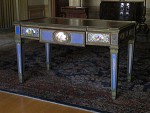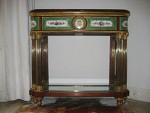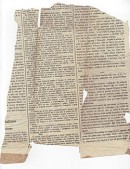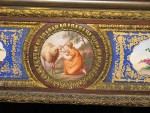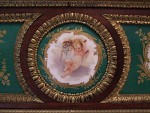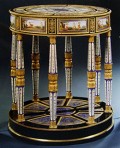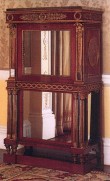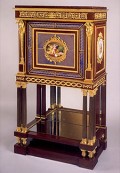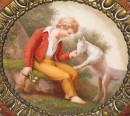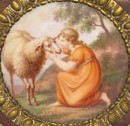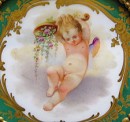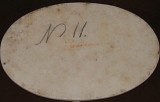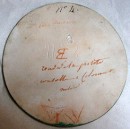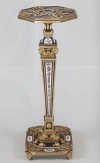The browser will either open the file, download it, or display a dialog.

Two Parisian Porcelain-mounted Tables by Louis-François Bellangé
Two exceptional tables of similar make have recently been identified in two different collections. The first is a large library table or flat desk (fig. 1) in the Doheny Mansion, a late nineteenth-century lavish home on the downtown campus of Mount-Saint-Mary’s College in Los Angeles, California. The second is a smaller piece, a pier table, now in a French private collection (fig. 2). Both tables are decorated with an impressive number of painted porcelain plaques showing gallant genre scenes and still life motifs.
The two tables were not part of Louis François Bellangé’s (1759–1827) known oeuvre until now, but they doubtlessly were made in the workshop of this Parisian cabinetmaker and were likely produced in the same period, between 1820 and 1823. The tables raise a series of questions about luxury taste and the production of precious furniture in Restoration Paris. They attest to the presence of trends other than the late Empire or neo-gothic styles among makers and collectors of decorative arts in this period, and shed new light on the roots of the eighteenth-century revival in the nineteenth century.
From a small number of archival documents in Paris it is possible to piece together Louis-François Bellangé’s life. Born in Paris[1] he was the younger brother of Pierre-Antoine Bellangé (1757–1827), a well-known Parisian cabinetmaker, who made an important career as official furniture purveyor during the reigns of Napoleon and King Louis XVIII.[2] In 1795, Louis-François married Marie-Madeleine Pignault, who bore him two children, a daughter, Madeleine-Sophie, born in 1798, and a son, Alexandre, born in 1799.[3] The family lived in a rented house at 41 rue du faubourg St Martin (current 10th arrondissement) until 1818, when Louis-François managed to buy a house nearby at 33 rue des Marais.[4]
In 1811, Bellangé received an order from the imperial household for a series of rather simple pieces of furniture.[5] This order occurred in the context of Napoleon’s commandes de soutien (support orders), intended to provide income and work to Parisian furniture workshops, which were facing a serious crisis at that time. While this suggests that, at the time, Bellangé may have been in financial trouble, business seems to have picked up in subsequent years. Documents show that, a decade later, the cabinetmaker was able to make some real estate acquisitions in addition to his house in the rue des Marais. He bought a large house nearby, in the rue de la Fidélité, and a country house to the north of Paris in the town of Stains (now in the suburbs).[6] These acquisitions attest to an obvious financial ease and the ambition to live as a comfortable bourgeois. They also may point to an intention to retire, using the property as a source of income. Bellangé probably did so at the end of 1822 or in 1823, leaving the running of the workshop to his son Alexandre (1799–1863). In 1825, in the wedding contract of his daughter, he is referred to as “former cabinetmaker (ancien ébéniste).[7] He died in Paris on August 13, 1827.[8]
The Doheny desk is a rectangular table with four conical legs. It is finished with mahogany veneer and has a drawer in one of the long sides. The ceinture (sides) of the tabletop is decorated with Paris porcelain plaques depicting gallant scenes and still lifes. On the long sides of the table top are two framed oval plaques, one showing three children dancing and playing the triangle in a rural landscape, the other showing two archers. On the short sides, two framed round medallions represent, respectively, a goatherd and a shepherdess. Eight other plaques, two on each side of the table, show still lifes. The spaces between the framed plaques are filled with unframed plaques that look like the maker was trying, but not quite succeeding—the color is too light—to imitate the famous eighteenth-century Sèvres colors called “nouveau bleu” and “beau bleu.” These blue plaques are ornamented with gold.
The table is marked at the bottom with individually stamped letters that spell out “Bellangé n°33 rue des Marais à Paris” (fig. 3). This way of “signing” a piece of furniture, while very different from the traditional furniture stamp containing only the last name and first name's initial that was used since the mid-eighteenth century by Parisian cabinetmakers, can be found on several pieces by Louis-François Bellangé and seems to have been standard usage in his workshop.
The provenance of the desk is unknown since the archives of the Doheny family, to which the desk belonged, unfortunately do not survive. It is possible that Edward and Estelle Doheny purchased it during one of the trips they made to Europe in 1912 and 1919, which included stays in London, Paris, and several cities in Italy.[9] The only available clue to the table’s history is a page of an Italian newspaper, dating from 1867, that was folded and put between the wood and one of the porcelain plaques, probably to create something of a buffer to protect the porcelain from shocks (fig. 4). This not only indicates a conservation operation on the piece during the late 1860s, but also suggests that at that time the desk was in Italy.
It is the only library table that we know of in Bellangé’s production, but there is a description of another porcelain-mounted piece attributed to him mentioned in a nineteenth-century sales catalog. In 1836, a table from the collection of “a British gentleman” (the reputed gambler, Brooke Greville), was offered for auction in London (after a pair of Bellangé torchères which are today in the castle of Wrotham Park in England). The table is described as “a library Table of tulip wood, richly mounted with or-moulu, with three drawers, with twenty four panels of Sèvres, painted with flowers, the top covered with morocco.”[10]
The second table (fig. 2) does not bear the Bellangé stamp, but its construction, ormolu elements, and porcelain plaques clearly indicate that it was produced in the same workshop and by the same maker as the Doheny desk. A pier or console table, it has a rectangular shape with rounded front corners on top and four fluted columnar legs with ormolu Corinthian capitals and spinning-top-shaped ormolu feet resting on a base. It has another four pilaster-shaped legs in the back. The front apron is decorated with six rectangular porcelain plaques displaying, on a white and green background, flower motifs on either side of a central medallion showing a flying putto spreading flowers out of a cornucopia.
Like the Doheny desk, this table is of unknown provenance. Present on the New York art market in the mid twentieth century, it was sold by Christie’s London in 1972, by Sotheby’s London in 1983, and again by Sotheby’s London in 2008.[11] It was stamped some time during these years with a spurious stamp “J. H. REISENER” [sic].[12] The pier table can be firmly related to several pieces of furniture made by Bellangé. The ormolu frames surrounding the plaques are identical to those on many of his other porcelain-mounted pieces, including the Doheny desk (figs. 5, 6), and a rich semi-circular pier table acquired by King George IV of England for his favorite, Lady Elizabeth Conyngham, in June 1822 (fig. 7). The pier table's fluted columns with ormolu capitals and bases are of the same making as those on two fall-front secrétaires (secretaries) now in the British Royal Collection and formerly at the J. Paul Getty Museum (figs. 8, 9).
Besides these visual comparisons with other Bellangé pieces, one can find descriptions of similar pier tables in early nineteenth-century private collections that we know included Bellangé pieces of furniture. The Paris and London curiosity dealer Alexis Delahante, who, as we shall see below, was closely involved with the trade of Bellangé’s production, owned until 1828 “a handsome Pier Console, enriched with specimens of French Porcelane, beautifully enameled.”[13] In April 1825, the ruined financier Pierre-Augustin Lapeyrière sold at auction, together with other Bellangé pieces (including the secrétaire in fig. 9): Deux consoles de porcelaine, montées en bronze, ouvrage inachevé. Les porcelaines restées en blanc sont destinées à être peintes; les bronzes ne sont point encore dorés (Two porcelain consoles, mounted in bronze, unfinished work. The porcelains left blank are destined to be painted; the bronze has not been gilded yet). The present pier table may have been one of these console tables. In that case, its porcelain decor must have been completed after 1825 for the person to whom the pair was sold.
The porcelain plaques on both pieces that are the subject of this article do not exhibit Sèvres marks, and probably come from an anonymous Parisian manufacturer. They show eighteenth-century-related subjects, such as pastoral love scenes, putti, wreaths of flowers, and still lifes, in a spirit that one would expect to find on pieces of furniture made between 1770 and 1790, but in a style that clearly is early nineteenth-century. The clothing of the goatherd and the shepherdess on the Doheny desk, for example, is clearly in a nineteenth-century neoclassical vein (figs. 10, 11), and the treatment of the face of the little putto in the medallion of the pier table (fig. 12) suggests a follower of Jean-Baptiste Isabey.
Inscriptions in red ink on the reverse of some of the plaques reveal a common practice of indicating for which piece of furniture they are intended. One of the medallions on the desk is marked with the simple word “bureau,” while the central medallion of the pier table bears a more complicated inscription that indicates both its subject and its exact placement:
un amour
ronde de la petite
console a colonnes
milieu (figs. 13, 14).[14]
To students of interior decoration, the Louis XVI-inspired furniture of Louis-François Bellangé, made at a time when gothic revival or late Percier and Fontaine style were in fashion, may appear as an anomaly. Bellangé’s furniture falls into a category that we may refer to as goût de curiosité (taste for the curiosity), relying on a term the Bellangé family and its contemporaries used to qualify this production.[15] The term corresponded to the taste of the amateur for pieces of furniture that were valued for their aesthetic qualities rather than their utility. Furniture in the goût de curiosité was purchased not out of need, but because the quality of its decor made it collectable and its ownership would be a mark of exceptional taste. The "curious" appears then as the opposite not only of the useful, but also of the banal, the average or, even, the generally fashionable. "Curiosity" goes beyond fashion. The "curious" object is one that, surrounded by trendy objects in an interior, attracts one’s guests’ eyes and generates discussion and, hopefully, admiration. Moreover, the "curious" object is one in which the material that makes up its decoration (such as porcelain plaques, for example), more than its shape or style, is the main purpose of its production and sale.
The production of objects in the goût de curiosité became Louis-François Bellangé’s specialty from 1815 onward, but this approach to furniture was not a new phenomenon in early nineteenth-century France. It was, in fact, related to a rather old tradition of luxury decorative arts. In France, the use of precious material in the manufacture of furniture originated in the seventeenth century with the use of exotic valuable veneers and, a little later, pietre dure panels first imported from Italy then directly produced for the French court by the Gobelins workshop. The tradition continued in the eighteenth century and set the fashion for imported Asian lacquer panels. In the 1760s, with the cabinetmaker Martin Carlin, the first instances of porcelain-mounted furniture appeared. Such pieces, in the eighteenth century, were decorated almost exclusively with Sèvres plaques.[16]
The fashion for furniture mounted with porcelain plaques experienced a dramatic crisis during the revolutionary period. These extremely costly and exclusive pieces, previously purchased by the wealthiest members of Ancien régime society, became disfavored in the 1790s as they were regarded as a despicable aristocratic form of decoration. Even during the Empire, when a court and an aristocracy were reconstituted and a market for precious furniture was restored, this tradition of porcelain-mounted furniture did not reappear,[17] even though the production of traditional porcelain objects survived and blossomed during the same period.
The sudden reappearance of porcelain-mounted furniture in Louis-François Bellangé’s workshop in the 1820s poses a historical puzzle. Why the return to the style, and why such a limited one, in Bellangé’s workshop alone and not in other more well-known furniture firms? It is tempting to understand this revival during the Restoration period as the search for a return to the pre-revolutionary aristocratic taste and way of life. But this is probably not the right explanation, for several reasons. First, the Bellangé workshop was rather small. Louis-François, contrary to his older brother Pierre-Antoine, was not working for the court as an official supplier, nor did he take part in any of the industrial exhibitions. He cannot be considered a tastemaker. Instead, his oeuvre is the expression of an uncommon taste rather than an open political discourse celebrating the return of the Bourbon dynasty. Secondly, to consider this eighteenth-century revival in terms of an ideological discourse implies that the neoclassical and Empire styles were associated with the Revolution and the Empire ideology. But, what is generally called, since the second half of the nineteenth century, French “Empire style” must be strictly separated from the Empire regime itself. In fact, the style was developed by the architects Charles Percier and Pierre-François-Léonard Fontaine in Rome in the second half of the 1790s, and it lasted until the end of the 1830s, as the successive editions of the architects’ Recueil de décorations intérieures, in 1801, 1812, and 1827 can attest.[18] It is important to emphasize that the style of decoration and the political orientation of a regime were not at all related in people’s minds. Louis XVIII's satisfaction with the taste in which French royal palaces were furnished at the moment of his restoration to the throne has been cited to show that the Empire style was not “imperial,” and that there was no real association between the Empire regime and the shapes and ornaments that blossomed during the period of Napoleon’s reign.[19] Thus, it would be rather too easy to consider a return to a Louis XVI fashion or aesthetic as a reactionary political statement.
A better way to understand the meaning of Bellangé’s old-fashioned production is to consider it in the context of its diffusion through trade. Most of Bellangé’s pieces of furniture were probably intended for the English market. This trade, after Waterloo, had much to do with the resumption of diplomatic relations between France and Britain and little with the return of the Bourbon dynasty to the French throne.[20]
French decorative arts had formed a major element in the interiors and collecting practice of the British aristocracy in the second half of the eighteenth century, but the importation of French goods was interrupted by the beginning of hostilities between England and Revolutionary France in 1792. With the exception of a short period during the Peace of Amiens (March 1802–May 1803), the embargo lasted until Napoleon’s fall. The imperial collapse spelled the return of wealthy British clients to the Parisian decorative-arts industry. There reappeared a market for collectibles. With a reemerging tourism to the French capital city, works of art appreciated for their rarity were sent back home across the English Channel as precious souvenirs. This trade mostly concerned small and precious objects of art such as Sèvres and Paris porcelains, ormolu mounts, clocks, etc., but in some cases it involved valuable and "curious" pieces of furniture. The British trade led to the reevaluation of eighteenth-century decorative arts and to the rise in France of a market for antique furniture, especially Boulle-style pieces and Louis XVI objects. As a result, it appears that eighteenth-century furniture was no longer considered as "second-hand goods," but as pieces with historical value.[21] It is interesting to note that while this way of collecting furniture was then rather new in France, it was not new in England, where this market had existed for decades, thanks in part to the fact that the French used to sell their furniture when it went out of fashion.[22]
The emergence of the mobilier de curiosité (curiosity furniture) must be understood in this context: the Louis XVI revival appears to have been a way for French furniture makers to take advantage, through the production of new pieces, of the appreciation of old French furniture by British tourists. Bellangé, as a producer, was involved in a commercial network that also included marchands de curiosités (dealers in curiosity). The latter both commissioned pieces and provided the precious materials—porcelain, hard stones, lacquer panels—with which to decorate them. In this regard, the taste for curiosity appears as a clear heritage of the patronage of the art dealers called marchands-merciers in the eighteenth-century Parisian luxury cabinetmaking industry.[23] The most important figures in this new nineteenth-century trade were undoubtedly Philippe-Claude Maëlrondt (1766–1824)[24] and Alexis Delahante (1767–1837). The latter, born in a modest noble family, had spent most of the Revolutionary period as an emigré in England and the Netherlands, where he had managed to make a successful career as a dealer in Old Master paintings. When he returned to France, after the restoration of the Bourbons in 1815, he became interested in the furniture trade.[25] As far as we know, he was the first dealer in those years to think about returning to the production of furniture as a support for precious porcelain plaques he would want to sell. It was in 1817, during a transaction with the British prince regent’s agent, that Delahante suggested that a couple of new “petits meubles” (small cabinets) be made to receive a pair of spectacular Sèvres plaques the prince was interested in acquiring.[26] The transaction appears to be the first instance, which suggests a return to fashion of porcelain-mounted furniture. It also gives a perfect definition for "curiosity" furniture: pieces without real practical use, that serve as supports for precious-material plaques that one would want to display in the best way.
Delahante was responsible for the trade of many pieces of Bellangé furniture, which were doubtlessly ordered by him for his wealthy clients. The most important of them, the prince regent, later King George IV of England, purchased through him the Conyngham pier table mentioned earlier (fig. 7), as well as four pairs of porcelain-mounted torchères(fig. 15). It is noteworthy that the two oval medallions on this table show scenes that are very similar to the ones depicted on two of the numerous rectangular plaques on the Doheny table. Both display groups of children dancing and frolicking in a landscape (figs. 16 to 19). The similarity of the decoration attests to the same origin for the providing of the plaques (Delahante) and suggests a similar date for both pieces.
The identification of these two tables adds two important pieces to the catalogue of Louis-François Bellangé’s work.[27] It also better illustrates the historically influential role that Bellangé, in his small workshop of 1815 to the 1820s, played in the eighteenth-century revival that was to blossom a few decades later. It is customary to situate the revival of the Louis XVI style in the second half of the nineteenth century and to associate it with figures like the Goncourt brothers and Empress Eugénie. Bellangé’s mobilier de curiosité demonstrates that the hiatus between the eighteenth century and its nineteenth-century reinterpretation was not so absolute. The role of Britain in the definition of this taste as early as the end of the 1810s and into the 1820s needs to be better investigated, and its revival in France must be placed in a broader geographical, social, and diplomatic context.
Sylvain Cordier
independent scholar
[1] Paris Birth Certificate, "Bellangé, Louis-François," 5Mi2 718, Archives of Paris, Paris.
[2] On the Bellangé family, see Sylvain Cordier, "La famille Bellangé, ébénistes à Paris de la Révolution au Second Empire" (PhD diss., Paris-Sorbonne University, 2009);and Denise Ledoux-Lebard, "Multiples Bellangé," Connaissance des Arts (November 1991) : 80–89.
[3] Inventory after death of Louis-François Bellangé, August 20, 1827, Minutier Central, study XXXIX, box 763, National Archives, Paris.
[4] Sale Chefd’HommeDesbarres Duferrin to Bellangé, August 8, 1818, Minutier Central, study CX, box, 711, National Archives, Paris.
[5] Commande de soutien (support order) to Bellangé, (May 30, 1811), Imperial Household, O2 513, National Archives, Paris.
[6] Sale Gaubert-Baugé to Bellangé, September 29, 1822, Minutier Central, study CXVIII, box 918, National Archives, Paris.
[7] Wedding contract Monvoisin-Bellangé, October 11, 1825, Minutier Central, study CX, box 787, National Archives, Paris.
[8] Inventory after death of Louis-François Bellangé, August 20, 1827.
[9] MaryAnn Bonino, The Doheny Mansion: A Biography of a Home (Los Angeles: Edizioni Casa Animata, 2008), 58–61.
[10] Greville sale, Christie and Manson, London, April 30, 1836, lot 46.
[11] Christie’s, London, March 23, 1972, lot 119; Sotheby’s, London, December 2, 1983, lot 126, Sotheby’s, London, March 5, 2008, lot 125.
[12] Jean-Henri Riesener (1734–1806) is one of the most well-known names among eighteenth-century cabinetmakers. This spurious stamp was undoubtedly a clumsy way to make the piece appear as a 1780 production, but it humorously failed at spelling Riesener’s name correctly.
[13] Delahante sale, Philipps, London, July 8, 1828, lot 144.
[14] "A cupid / round of the small / pier table with columns / middle."
[15] The title of the auction sale organized by Alexandre with the remains of his father’s production in 1832 referred to the lots as “objets de haute curiosité.” Notice, Bellangé père sale, Gibé, Paris, April 2–3, 1832.
[16] Alexandre Pradère, Les ébénistes français, de Louis XIV à la Révolution (Paris: Chêne, 1987), 344.
[17] Cordier, La famille Bellangé,1:245–47.
[18] Charles Percier and Pierre-François-Léonard Fontaine, Recueil de décorations intérieures, comprenant tout ce qui a rapport à l’ameublement (Paris: Didot, 1801; rev. 1812 and 1827).
[19] See especially Colombe Samoyault-Verlet, "L’ameublement des châteaux royaux à l’époque de la Restauration," in Un âge d’or des arts décoratifs, ed. Daniel Alcouffe, Anne Dion-Tenenbaum, and Amaury Lefebure (Paris: Réunion des Musées Nationaux, 1991), 42.
[20] On this subject see, for instance, Geoffrey de Bellaigue, "Philippe-Claude Maëlrondt, Supplier to George IV," Burlington Magazine 146, no. 1215 (June 2004): 390; and Thibault Wolvesperges, "Le marché des meubles et objets d’art dans les premières années du XIXe siècle: Maëlrondt, le dernier des marchands merciers," Collections et marché de l’art en France, 1789-1848 (Rennes: Presses Universitaires, 2005), 215.
[21] Wolvesperges, "Le marché des meubles," 219.
[22] The most famous instance is probably that of the Cucci cabinets made for Louis XIV, sold by the French Royal household in 1751, and now in the collection of the dukes of Northumberland at Alnwick Castle. Daniel Alcouffe, "Les ventes de Louis XV," De Versailles à Paris, le destin des collections royales (Paris: Centre Culturel du Panthéon, 1989), 48; and Bertrand Rondot, "Cabinets Cucci," Louis XIV, l’homme et le roi (Versailles: Skira Flammarion, 2009), 242–45. One can also mention the countess of Provence’s Riesener jewel cabinet of 1787, sent to England after the Napoleonic administration’s refusal to acquire it for the Empress’s use, and conserved in the British Royal Collection at Windsor Castle since 1825. Hugh Robert, "Quite Appropriate for Windsor Castle," Furniture History (London: Furniture History Society, 2000), 119 and 131.
[23] Wolvesperges, "Le marché des meubles," 215.
[24] De Bellaigue, "Philippe-Claude Maëlrondt," 386–95; and Sylvain Cordier, "The Dispersal of Bellangé Furniture from the Maëlrondt Collection," in Makers, Dealers and Collectors: Studies in Honour of Geoffrey de Bellaigue, Furniture History, ed. Jonathan Marsden (London: Furniture History Society, 2007), 29–41.
[25] Sylvain Cordier, "Inventer et vendre le meuble historique: Le goût et la carrière d’Alexis Delahante, peintre, expert et marchand de curiosités, Revue de l’Art (forthcoming).
[26] The letter from François Benois to Sir Benjami Bloomsfield from the Royal Household, September 9, 1817, documenting this transaction was found by Geoffrey de Bellaigue in the Royal Archives, and published in Geoffrey de Bellaigue,French Porcelain in the Collection of Her Majesty the Queen (London: The Royal Collection, 2009), 1:75.
[27] The Bellangé family and its production will be the subject of a book, Sylvain Cordier, Bellangé, une histoire du goût au XIXe siècle (Paris: Mare et Martin, forthcoming).


